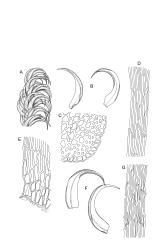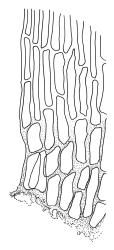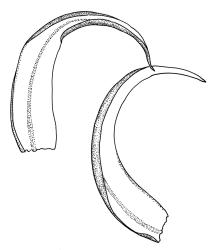- ≡ Hypnum cossonii Schimp., Musci Eur. Nov. 5 (1866)
- ≡ Drepanocladus cossonii (Schimp.) Loeske, Moosfl. Harz. 306 (1903)
- ≡ Limprichtia cossonii (Schimp.) L.E.Anderson, H.A.Crum & W.R.Buck, Bryologist 93: 463 (1990)
- = Amblystegium intermedium Lindb., Musci Scand. 33 (1879)
- ≡ Drepanocladus revolvens subsp. intermedius (Lindb.) Grout, Moss. Fl. N. Amer. 3, 107 (1931)
Drepanocladus revolvens sensu Beever et al. 1992.
Plants robust, red- or brown-green (especially at stem tips), occasionally nearly black below, forming interwoven mats on water-logged soil; shoots <2 mm wide. Stems to at least 50 mm, irregularly branched, in cross-section with a hyaloderm surrounding 3–4 layers of thick-walled and pigmented cells, and a core of larger, less thickened cells; lacking a central strand in N.Z. material. Stem and branch leaves not differentiated, strongly falcate-secund to nearly circinate, smooth moist or dry, lanceolate and evenly tapered to a short acuminate apex, concave near base and becoming tubulose in upper portion, entire, c. 2.0–2.5 × 0.35–0.4 mm when flattened (difficult to measure due to curvature); mid laminal cells linear, smooth, thick-walled and porose, the lumina ± blunt at ends, mostly (45–)54–75(–90) × c. 3–4 µm, not altering at leaf apex; basal laminal cells shorter, more pigmented and strongly porose in a band at leaf base; alar cells scarcely differentiated, a small number of cells short-rectangular or subquadrate, and occasionally one or two cells slightly enlarged in the extreme angle. Costa rather slender, extending about ⅔ the leaf length. Pseudoparaphyllia not seen, reportedly foliose in European material. Paraphyllia absent.
Apparently dioicous. Neither sex organs nor sporophytes seen in N.Z. material.
Hedenäs 1989, figs. 6–7; Blockeel 2000, fig. 1b.
The strongly falcate-secund curvature and strong pigmentation of the leaves, together with occurrence in alpine seepages facilitate recognition of this species. Most of the material which has been previously referred to Drepanocladus revolvens (cf. Fife 1995; Beever et al. 1992) is here referred to S. cossonii.
Warnstorfia fluitans has been confused with this species. The habit of the two species is markedly different, and it is only when W. fluitans forms compact and strongly red-pigmented colonies that such confusion is likely. S. cossonii has the outmost layer of stem cortical cells thin-walled and inflated and lacks a central strand (in N.Z. material); these features facilitate its distinction from pigmented forms of W. fluitans.
SI: Nelson (Cobb Valley and vicinity, St. Arnaud Range), Canterbury (Temple Basin), Otago (Old Man Range).
Bipolar. Widespread in northern Europe (Hedenäs 1989) and North America and scattered in northern South America (Hedenäs 2003).
In alpine flushes and margins of alpine tarns; apparently mesotrophic. In flushes, this species nearly always occurs with the rush Schoenus pauciflorus. From 1100 (Cobb Valley, Nelson L.D.) to at least 1580 m (St. Arnaud Range, Nelson L.D.). In addition to S. pauciflorus, this species is often associated with Campyliadelphus stellatus, Fissidens adianthoides, Warnstorfia sarmentosa, W. fluitans, and Drosera arcturi. Hedenäs (1989, p. 22) characterised it as a species of calcium-rich habitats in northern Europe.











